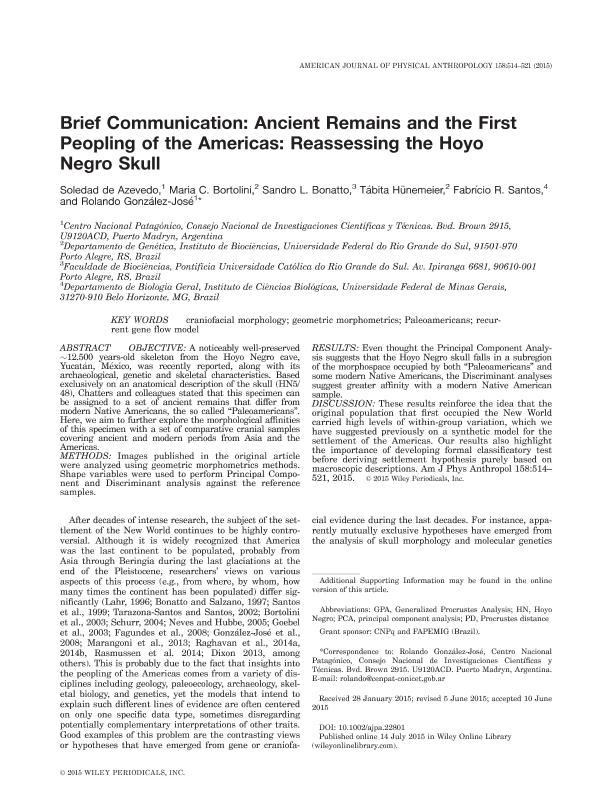Mostrar el registro sencillo del ítem
dc.contributor.author
de Azevedo, Soledad

dc.contributor.author
Bortolini, Maria Catira

dc.contributor.author
Bonatto, Sandro Luis

dc.contributor.author
Hünemeier, Tábita
dc.contributor.author
Santos, Fabricio R.

dc.contributor.author
González José, Rolando

dc.date.available
2018-04-18T14:58:22Z
dc.date.issued
2015-07
dc.identifier.citation
de Azevedo, Soledad; Bortolini, Maria Catira; Bonatto, Sandro Luis; Hünemeier, Tábita; Santos, Fabricio R.; et al.; Ancient remains and the first peopling of the Americas: Reassessing the Hoyo Negro skull; Wiley; American Journal Of Physical Anthropology; 158; 3; 7-2015; 514-521
dc.identifier.issn
0002-9483
dc.identifier.uri
http://hdl.handle.net/11336/42446
dc.description.abstract
Objective A noticeably well‐preserved ∼12.500 years‐old skeleton from the Hoyo Negro cave, Yucatán, México, was recently reported, along with its archaeological, genetic and skeletal characteristics. Based exclusively on an anatomical description of the skull (HN5/48), Chatters and colleagues stated that this specimen can be assigned to a set of ancient remains that differ from modern Native Americans, the so called “Paleoamericans”. Here, we aim to further explore the morphological affinities of this specimen with a set of comparative cranial samples covering ancient and modern periods from Asia and the Americas. Methods Images published in the original article were analyzed using geometric morphometrics methods. Shape variables were used to perform Principal Component and Discriminant analysis against the reference samples. Results Even thought the Principal Component Analysis suggests that the Hoyo Negro skull falls in a subregion of the morphospace occupied by both “Paleoamericans” and some modern Native Americans, the Discriminant analyses suggest greater affinity with a modern Native American sample. Discussion These results reinforce the idea that the original population that first occupied the New World carried high levels of within‐group variation, which we have suggested previously on a synthetic model for the settlement of the Americas. Our results also highlight the importance of developing formal classificatory test before deriving settlement hypothesis purely based on macroscopic descriptions. Am J Phys Anthropol 158:514–521, 2015.
dc.format
application/pdf
dc.language.iso
eng
dc.publisher
Wiley

dc.rights
info:eu-repo/semantics/openAccess
dc.rights.uri
https://creativecommons.org/licenses/by-nc-sa/2.5/ar/
dc.subject
Craniofacial Morphology
dc.subject
Geometric Morphometrics
dc.subject
Paleoamericans
dc.subject
Recurrent Gene Flow Model
dc.subject.classification
Otras Ciencias Biológicas

dc.subject.classification
Ciencias Biológicas

dc.subject.classification
CIENCIAS NATURALES Y EXACTAS

dc.title
Ancient remains and the first peopling of the Americas: Reassessing the Hoyo Negro skull
dc.type
info:eu-repo/semantics/article
dc.type
info:ar-repo/semantics/artículo
dc.type
info:eu-repo/semantics/publishedVersion
dc.date.updated
2018-03-28T18:13:19Z
dc.identifier.eissn
1096-8644
dc.journal.volume
158
dc.journal.number
3
dc.journal.pagination
514-521
dc.journal.pais
Estados Unidos

dc.journal.ciudad
New York
dc.description.fil
Fil: de Azevedo, Soledad. Consejo Nacional de Investigaciones Científicas y Técnicas. Centro Científico Tecnológico Conicet - Centro Nacional Patagónico; Argentina
dc.description.fil
Fil: Bortolini, Maria Catira. Universidade Federal do Rio Grande do Sul; Brasil
dc.description.fil
Fil: Bonatto, Sandro Luis. Pontificia Universidade Católica do Rio Grande do Sul; Brasil
dc.description.fil
Fil: Hünemeier, Tábita. Universidade Federal do Rio Grande do Sul; Brasil
dc.description.fil
Fil: Santos, Fabricio R.. Universidade Federal de Minas Gerais; Brasil
dc.description.fil
Fil: González José, Rolando. Consejo Nacional de Investigaciones Científicas y Técnicas. Centro Científico Tecnológico Conicet - Centro Nacional Patagónico; Argentina
dc.journal.title
American Journal Of Physical Anthropology

dc.relation.alternativeid
info:eu-repo/semantics/altIdentifier/doi/http://dx.doi.org/10.1002/ajpa.22801
dc.relation.alternativeid
info:eu-repo/semantics/altIdentifier/url/https://onlinelibrary.wiley.com/doi/abs/10.1002/ajpa.22801
Archivos asociados
